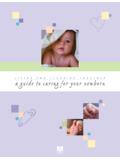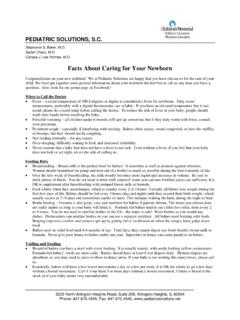Transcription of CARE OF THE NEWBORN: THERMOREGULATION
1 care OF THE newborn : THERMOREGULATION A newborn is at a particular disadvantage in maintaining a normal body temperature. With the neonate s large body surface and lean subcutaneous fat, the newborn loses about four times as much heat as the adult. Poor thermal stability is greatly due to the excessive heat loss rather than heat production. Heat loss from the body surface to the environment takes place by four avenues: 1. Convection is the loss of heat from the warm body surface to cooler air currents.
2 Examples: air-conditioned rooms. Removal from an incubator. 2. Radiation losses occur when heat transfers from the heated body surface to cooler surfaces and objects not in direct contact with the body. Example: walls of an incubator. 3. Evaporation is the loss of heat incurred when water is converted to vapor. 4. Convection is the loss of heat to a cooler surface by direct skin contact. Example: chilled hands. After birth, the highest losses of heat generally result from radiation and convection. With a newborn baby losing excessive amounts of heat like this, precautionary measures need to be taken immediately before a serious situation may occur.
3 To regulate temperature of the newborn , the following protocols from Presbyterian Hospital of Dallas were obtained: A baby once received from delivery will have temperature taken every 30 minutes until vitals are maintained for at least two hours. Baby is to wear hat provided to maintain temperature. Baby will be placed under warmer if temperature falls below F. Baby while under warmer will have servocontrol probe to monitor temperature. Baby s temperature, along with vitals, will be taken every two hours or PRN.
4 Baby to have only hat, diaper, t-shirt, and one blanket swaddling, and one blank to cover. If additional blankets or heated blankets are needed, they are followed only with protocol orders. Babies are at excessive risk for hyperthermia. Other protocols maintained by Presbyterian exhibit whether or not a mother may/may not have the infant in her room when complications exist. If a baby s temperature falls below F, the baby will be placed under the warmer until F is regulated. Mom will be notified that baby Ajust got a little cold@ and needs to be under the warmer until the baby warms up a little.
5 The nurse does not tell the mother that the baby=s temperature has dropped. The pediatrician is first notified when a complication exists with the newborn . It is at his/her discretion in which the parents are notified. The nurse takes no action in notifying the parents of the situation. Before discharge, the nurse in charge of mom and baby explains the importance of how and why to maintain the baby s temperature. For example, when giving a newborn a bath, explain the importance of having the water at lukewarm temperature.
6 Babies get really cold, really fast. After giving the bath, stress to mom to cover the head when drying off baby. This is the baby s main source of heat loss. Babies should also be dressed according to the weather outside. Dress him/her is something ideally that you would wear for that day. Babies too frequently are overdressed and therefore, this can lead to serious problems. A baby, however, should be swaddled in a light blanket. Lastly, avoid open drafts such as windows, open doors, air conditioners, etc.
7 This will reduce the amount of cool air that the baby doesn t need. In conclusion, a thermal environment is essential to minimize the newborn s chances of complications arising. Measures taken to keep baby warm and comfortable and protocols that are used in situations should be ascertained to prevent heat loss substantially.











